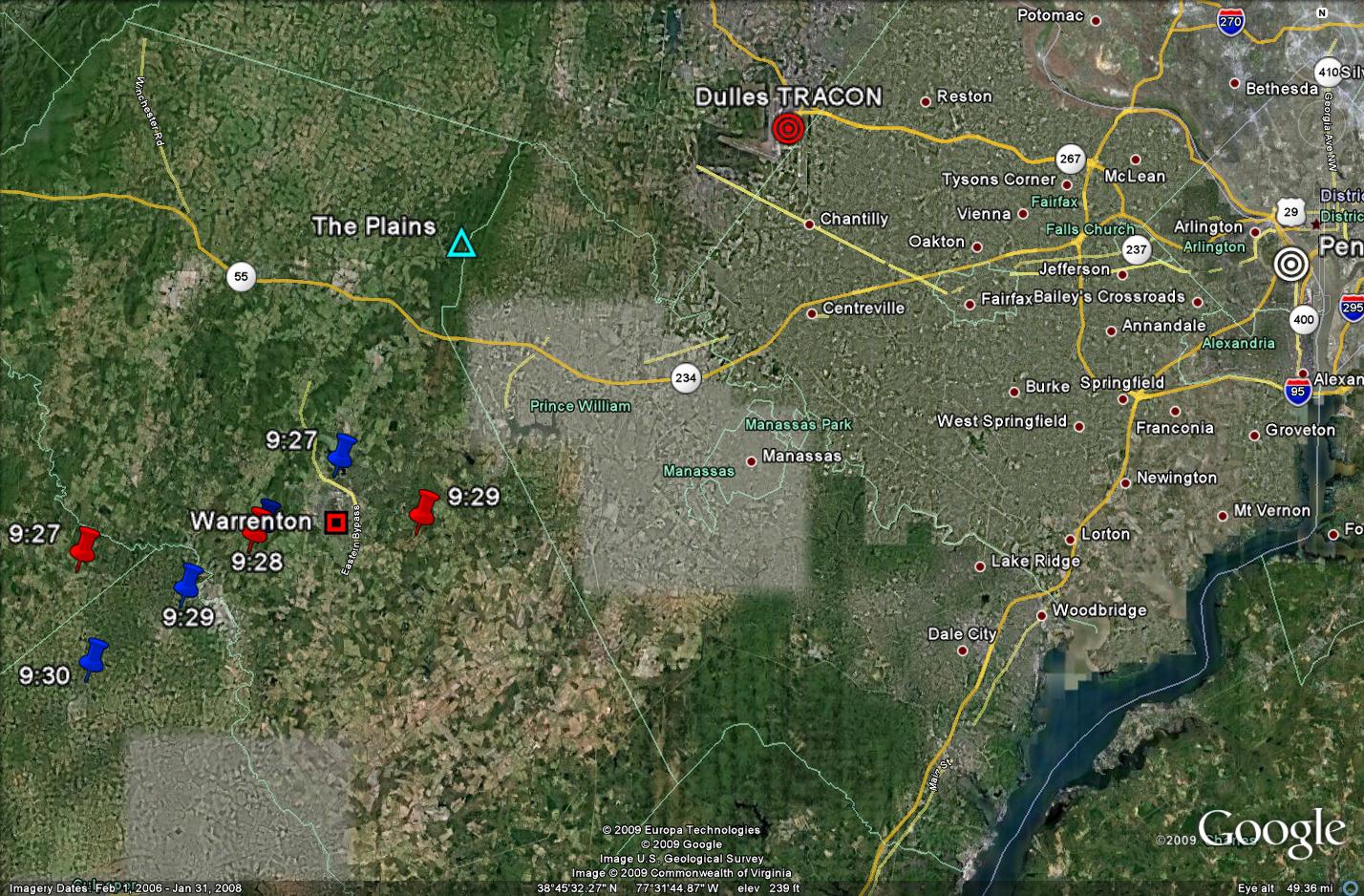Addendum March 22, 2010
The purpose of this addendum is to insert an audio clip of a conversation shortly after 9:25 between Herndon Center and Indianapolis Center (ZID). Herndon initiated the call to learn whatever it could about the loss of AA 77.
Indianapolis reported that the aircraft was off radar and presumed lost. ZID assessed that AA 77 was not involved in the World Trade Center events because the time of loss was at the same time as events in New York.
The Herndon Center caller assessed, based on time and distance factors that the most likely target in danger was the Sears Tower in Chicago. The conversation can be heard here. 092506 Herndon and ZID discuss AA77
My Assessment
This conversation is clear evidence that FAA Herndon Center and, by extension, FAA Headquarters did not know that AA 77 was bearing down on the nation’s capital. It is further evidence that Norman Mineta was clearly mistaken in his recall of events that morning. There is no reasonable way that he could have known about AA 77.
At that time, 9:25, no one above the scope level at Dulles TRACON had any information whatsoever about AA 77. Although two controllers spotted a “no tag” they had no idea what they had seen and information available at Dulles TRACON did not become actionable until 8 minutes later when the general alarm was sounded.
Original Article
In part one we established that Washington Center, ZDC, was not looking for AA 77 as a primary-only target and never detected the plane. Moreover, its conversation with Indianapolis Center about AA77 and its internal conference among area supervisors were not shared with Dulles TRACON, IAD. In this article we continue the track of AA 77 and relate it to IAD using primary sources–air traffic control conversations, the flight data recorder, and radar files. And we start with IAD, itself.
Dulles TRACON, IAD
Dulles TRACON no longer existed by the time the Commission began its work. In December, 2002, FAA commissioned a consolidated facility, Potomac TRACON, which assumed the responsibilities of the TRACONs at Dulles, National, and Baltimore airports and Andrews Airfield to solve known air traffic inefficiencies and obsolescence issues as detailed in the linked document.
The Commission Staff toured both Dulles and National Towers and TRACONS. Concerning the latter, we simply saw empty rooms at both locations. To interview participants of the day we had to track them down wherever they were; several at Potomac TRACON, which we twice visited.
We determined that around 9:25 IAD did see, but did not recognize the threat posed by AA 77. This is the IAD story and we begin with the first known primary source evidence.
See that no tag?
In the 9:25 timeframe a controller at the IAD South Departure position said: “see that no tag, there?” A co-worker responded, “I do.” The controller then said, “I’ll just flash him on to Wash or Center,whatever.” The co-worker responded, OK. That short six second exchange can be heard here No Tag.
It is speculative, but probable, that the controllers were seeing the track that was AA 77. It is also possible that they were referring to something else entirely. Given that it was AA 77 they did not recognize it as a threat and there is no evidence that the information was shared internally to IAD or that “Wash or Center” saw the flash.
According to the flight data recorder readout AA 77 was at 18,000 feet, technically just entering Class E airspace. Whatever the technical division of air space responsibility no FAA facility recognized the threat. Further, no one cued NEADS to look for that “no tag.”
FAA did acknowledge that early spotting of a “no tag” in its secondary source documents provided to the Commission. We will consider those documents but first we need to talk about a second opportunity to see the AA 77 primary only track, this one by IAD South Departure and two ZDC Sectors, separately.
A Second IAD opportunity
In my Commission work I identified one plane that might have caused IAD (or ZDC) to recognize the approach of AA 77. A graphic of the track of that plane, labeled M3 1531, is part of a series of slides concerning the approach of AA 77 and is inserted here, updated.
The two aircraft were separated vertically by more than 6000 feet. AA 77 was just passing through 10,000 feet altitude into IAD designated airspace. The point of spatial intersection was just West of Warrenton, Virginia.
In air traffic communications we first hear about M3 1531 around 9:26. Dulles South Departure attempted a manual hand off of the southwesterly transiting aircraft to ZDC Casanova Sector. That controller exchange can be heard at this link. M3 1531 Casanova Tape 19 side 1.
In a second attempt a minute later a different ZDC controller acknowledged “not that VFR guy.” “VFR” in this context is not a reference to AA 77; it is a reference to a transponding aircraft. IAD successfully handed M3 1531, who was VFR, off to ZDC, Azalea Sector.
At no time does any controller notice or comment on a primary only aircraft headed east. Here is the relevant conversation. M3 1531 Azalea Tape 19 side 1 and M3 1531 Azalea Tape 19 side 2 It is in two parts because the transmission occurred at the end of one cassette tape and the beginning of another, as provided to the Commission and as archived by NARA.
Here is a Google Earth plot of the spatial intersection of AA77 and M3 1531 just West of Warrenton, Virginia. As established earlier the two aircraft were 6000 feet apart in vertical separation.

I know of no other primary source air traffic control transmissions which relate in any way to the approach of AA 77. To see how FAA treated this information we next turn to a discussion of FAA assessments in the aftermath.
FAA Assessments
To sumarize, FAA established a time of 9:25 in its early assessments. That assessment held at least through September 18, 2001, as memorialized in the Administrator’s Briefing Book.
In later assessments, including a March 2002 draft report, the 9:25 time no longer appeared. By then FAA had settled on a time that equated to IAD sounding the alarm to National TRACON/Tower and to the White House/Secret Service.
Retrospectively, FAA established that IAD controllers may have seen the primary only track as early as 9:25, but there is no evidence that IAD recognized the threat any earlier than 9:32.
A FAA “Chronology of Events“, unattributed, but fax time-stamped “6:18AM SEP 12, 2001” demonstrates the confusion within FAA as to what happened. A 9:25 entry states: “AAL77 Lost at 9:25AM York Kentucky.” A 9:33 entry states: “DCA notified check Hotline activated; primary 3 miles south, now 1 mile.” No mention is made of anyone noticing the track that would later be identified as AA 77.
The next day, in an internal summary prepared at 9:00 on September 13, 2001, FAA’s AAT-20 documented this information: “0856 Radar contact is lost. No Further contact with aircraft. Dulles ATCT [IAD] (bolding in original) 0925 (estimate) Controller observes primary target at high-speed transitioning west to east toward DC. 0933 Controller informs Operational Supervisor, whom in turns advises Washington National (DCA).”
That is an accurate statement, based on primary source information. As we have established, a controller saw a “no tag” at 9:25 and did not recognized it as a threat. The use of the word “controller,” singular, morphed into “controllers,” plural, as FAA prepared its Administrator for Congressional hearings.
That morphing from singular to plural was likely based on individual controller statements taken as part of FAA’s accident package preparation for submission to NTSB. Retrospectively, individual controllers may have recalled that they did see the primary only track.
The fact remains, however, that none of them saw it as a threat and none of them alerted their supervisors. That alert did not come until Danielle O’Brien recognized a problem; we will discuss that in a subsequent article.
The Administrator’s Briefing Book
As of September 18, 2001, at 5:20 PM the Administrator’s Briefing Book for Congressional hearings contained the following entries. “0925:00 Between 0925:00 and 0930:00 (time is approximate based on personnel statements) – Several controllers at Dulles TRACON observe a primary radar target (unidentified but later confirmed to be AAL 77).” “0933:00 (Time is approximate based on personnel statements – Dulles TRACON advises…Secret Service of an unknown aircraft heading in the direction of the White House…”
This version of the briefing book is the day after the White House meeting to discuss the events of the day and is likely the same version used by FAA representatives at that meeting.
The acknowledgment that the controller’s 9:25 observation may have correlated to AA 77 was dropped in subsequent FAA summaries. An undated “Chronolgical Events at Dulles Tower on September 11, 2001,” contains this entry: “1332;20 (time approximate) Controller at Dulles Tower working the Final West position informs the other controllers in the radar room about the target observed moving estbound.”
Months later, in its 21 March 2002 draft report “The Air Traffic Organization’s Response,” the first mention of AA 77 as a threat is the 9:33 alert.
A Personal Comment
This look at FAA staff work in some detail does indicate that FAA was aware of all the relevant air traffic control tapes. They went into the White House meeting with accurate primary source information. I extrapolate from this that they knew, from their perspective, the actual notification times to the military.
I estimate they must have know the centrality of NEADS to the military equation. They certainly knew there was no 9:24 notification time to NORAD concerning AA 77. Whatever their position, it was subsumed at the White House meeting.
The Commission Report
The Staff wrote: “At 9:32, controllers at the Dulles Terminal Radar Approach Control “observed a primary radar target tracking eastbound at a high rate of speed.” This was later determined to have been Flight 77.”
At one time we considered a time of 9:25 but the convergence of information dictated a later time. We concluded that 9:32 was the earliest time that situational awareness developed at IAD; they processed what they were seeing and then sounded the alarm.
Next Up
Before we turn to the awareness and subsequent alarm we will briefly examine a phone call between FAA’s Eastern Region and IAD in the 9:29 time frame. Recall that we established that Eastern Region, an administrative headquarters, was dictating the exchange of information. As a preview of the next article, Eastern Region called to inquire not about AA 77 but about UA 175.
After that we will turn to Danielle O’Brien and the actions she and her supervisor took.

One thought on “The Ghosts of 9-11: AA 77; a real ghost, unseen (part 2)”
Comments are closed.